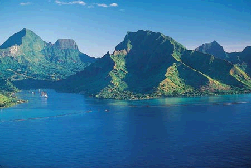Dr. Michael Poole
Biography
Documentaries
Published Papers
Whale Sanctuary
Dr. Michael Poole is the former Director of the Marine Mammal Research Program at the Island Research Center & Environmental Observatory (CRIOBE, a research station of the University of Perpignan, France) on Moorea, French Polynesia. He also holds the appointment of Research Associate with the National Oceanic Society, a U.S.-based research foundation. He is a charter member of the Society for Marine Mammalogy; a member of the American Society of Mammalogists; and a charter member of the South Pacific Whale Research Consortium, of which he is part of the Executive Committee. From 1996-98 Michael held the prestigious two-year appointment of Research Fellow at the Institute of Marine Sciences of the Un. of California, Santa Cruz.
Michael has conducted scientific research on whales and dolphins since 1980. He received a Bachelor's Degree from the University of Miami, Florida, assisting studies on manatees and false killer whales. His three years of Master's Degree research (California State University, Sonoma) discovered the previously unknown route and timing used by gray whale females and calves migrating northward along the California coast. As a student of the Dr. Kenneth Norris, the world's foremost authority on dolphins and whales, Michael's Ph.D. (University of California, Santa Cruz) was based on six years of spinner dolphin research at Moorea and Tahiti. He has also studied bottlenose dolphins in the Gulf of Mexico and gray whales in Baja California, Mexico.
Since 1987, much of Michael's efforts (partially modeled after Dr. Jane Goodall's 40 years of chimpanzee research in Africa's Gombe Reserve) have been on spinner dolphins in French Polynesia. He has also studied humpback whales, rough-toothed dolphins, bottlenose dolphins, pilot whales, and other species at eight islands. Michael discovered that some humpback whales use French Polynesia as a breeding ground; this was previously unknown to science. Due to 20th century industrial whaling, humpback whales were reduced by 97%. Michael's research is providing valuable data on these magnificent, endangered giants. In 1988 Dr. Poole established French Polynesia's first dolphin/whale sighting and stranding network. It has received over 1000 reports on 20 species of dolphins and whales at or near 30 different islands. Michael has given reports on his research to the United Nations' Cetacean Specialist Group of the South Pacific Regional Environmental Program.
Dr. Poole's efforts to help rescue "Humphrey" the humpback whale in the Sacramento River were featured on ABC's 'Nightline' and 'Good Morning America'. In 1993 Michael's research on soil erosion and coral reef health at Moorea was featured in the Turner Broadcasting System (TBS) Audubon Society TV special, "Cathedrals of the Sea". In 1994 Michael and his research on humpback whales were featured in the RFO TV magazine "Aigue Marine" shown in France and its overseas territories. In 1996 Michael was a scientific consultant for a French TV (Canal Plus) special "Les Chasses du Dauphin-Roi" on bottlenose dolphins. Since 1998, Michael and his research on spinner dolphins have been repeatedly featured in the TV documentary, "Ocean Acrobats: The Spinner Dolphins" shown on Discovery Channel and Animal Planet. In 1998 Michael and his research on Rangiroa atoll's bottlenose dolphins were featured on the FRANCE 2 television special "Les Nouveaux Mondes". Since 1999 Michael's research has been repeatedly featured on Discovery Channel and Animal Planet in another documentary called "Shark Central: The Secrets of Rangiroa Atoll". In 2000 he was a scientific consultant for the extraordinary BBC/Discovery Channel series "The Blue Planet". In 2001 his research on humpback whales was featured in "La Dance des Baleines", a documentary shown on the French station Canal Plus; in 2004 this same documentary was shown on National Geographic TV in Asia, and in 2005 will be shown in the U.S. In 2002, 2003, and 2004 his research and eco-tours were featured on two documentaries shown on Vox Tours TV in Europe.
To further heighten public awareness locally and internationally about the plight of these animals and about their presence in French Polynesia, in 1994 Dr. Poole, with French Polynesia's Postal and Telecommunications Office, created three postage stamps featuring whales and dolphins; two stamps used Michael's photographs. He also wrote the informative philatelic brochures which accompanied the series, and which were sent to stamp collectors around the world. In 1995 Dr. Poole produced two posters (one in Tahitian, one French) featuring color photographs and text on whales and dolphins of French Polynesia and the Cook Islands. These posters, financed by the Ministry of the Environment, were given gratis to all the islands' schools. In 1996 Michael produced another poster, featuring black and white illustrations of the 24 species of dolphins and whales in French Polynesia. These posters were also given gratis to the schools. In 1998 the Ministry of the Environment released a second edition of these posters.
In 1996 Dr. Poole worked with David Doubilet (renowned underwater photographer) and Peter Benchley (famous author of "JAWS", "The Deep", "Beast") for a June 1997 National Geographic magazine article. In addition, he coordinated a week-long eco-tourism trip at Moorea for the National Wildlife Federation, the US's largest conservation organization. Michael also worked with a Japanese crew filming Moorea's dolphins and whales.
Dr. Poole's most significant success came after ten years of effort when, in May 2002, French Polynesia's government finally accepted Michael's proposition and his draft legislation to create a whale and dolphin sanctuary within all of the territory's Exclusive Economic Zone, an area half the size of the continental US. It is one of the largest sanctuaries in the world. The Cook Islands, Samoa, Papua New Guinea, and New Caledonia have likewise declared sanctuaries in their respective EEZs.
Dr. Poole is the founder of Dolphin & Whale Watching Expeditions, a boat-based eco-tour that takes people to observe and to learn about the lives of wild, free-ranging dolphins and whales. And finally, Michael is married to Mareva Tepau, one of Tahiti's best traditional dancers. They have two sons, Temoana ("the deep blue sea") and Tearenui ("the great wave").
Contact






